《儿科学》课程教学课件(PPT讲稿)19 Pediatric Tuberculosis
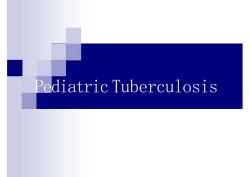
Pediatric Tuberculosis
Pediatric Tuberculosis
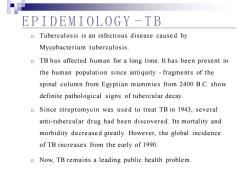
EPIDEMIOLOGY-TBTuberculosis is an infectious disease caused byMycobacterium tuberculosis. TBhas affected human for a long time. It has been present inthe human population since antiquity -fragments of thespinal column from Egyptian mummies from 240o B.C. showdefinite pathological signs of tubercular decay.Since streptomycin was used to treat TB in 1943. several口anti-tubercular drug had been discovered. Its mortality andmorbidity decreased greatly. However,the global incidenceofTBincreases from theearlyof1990 Now, TB remains a leading public health problem
E P I D E M I O L O G Y - T B □ Tuberculosis is an infectious disease cause d by Mycobacterium tuberculosis. □ TB has affected human for a long time. It has been present in the human population since antiquity - fragments of the spinal column from Egyptian mummies from 2400 B.C. show definite pathological signs of tubercular decay. □ Since streptomycin was us e d to treat TB in 1943, several anti-tubercular drug had been discovered. Its mortality and morbidity decre ase d greatly. However, the global incidence of TB increases from the early of 1990. □ Now, TB remains a leading public health problem

EPIDEMIOLOGY-TBInternationally2billion infected10%develop clinical disease8million newcasesannually3million deaths eachyearthe toplo list for all-cause, all-age worldwide mortality95%in developing countriesMortality in developing countries: 200/10,000 peryear;Mortality in China: 532/10,000Children40%ofTBisinchildrenyoungerthan15yr1.3million new casesannually400,000 deaths are childrenMore likely to develop TBMChildren with TB are always neglected
E P I D E M I O L O G Y - T B Internationally 2 billion infected 10% develop clinical dise as e 8 million ne w c a s e s annually 3 million deaths each year the top10 list for all-cause, all-age worldwide mortality 95% in developing countries Mortality in developing countries: 200/10,000 per year; Mortality in China: 532/10,000 Children 40% of TB is in children younger than 15yr 1.3 million new cas e s annually 400,000 deaths are children More likely to develop TBM Children with TB are always neglected
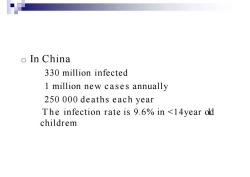
In China330 million infected1 million new cases annually250 000 deaths each yearThe infection rate is 9.6% in <14year ddchildrem
□ In China 330 million infected 1 million new c a s e s annually 250 000 deaths each year T h e infection rate is 9.6% in <14year old childrem

300250200Tuberculosis150Tuberculous100Meningitishhhi'0096980204*06089294The case number oftuberculosis and tuberculous meningitisinCHCMUfr0m1992~2009
100 150 300 250 200 T u b e r c u l o s i s Tu b e r c u lo u s Me ni ngi ti s 50 0 92 94 96 98 ' 0 0 ' 0 2 ' 0 4 ' 0 6 ' 0 8 The case number of tuberculosis and tuberculous meningitisin CHCMU from 1992~2009
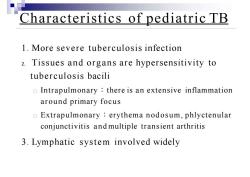
Characteristics of pediatric TBl.More severe tuberculosis infection2. Tissues and organs are hypersensitivity totuberculosis bacili Intrapulmonary : there is an extensive inflammationaround primary focus Extrapulmonary : erythema nodosum, phlyctenulalconjunctivitis andmultiple transient arthritis3. Lymphatic system involved widely
Characteristics of pediatric TB 1. More severe tuberculosis infection 2. Tissues and organs are hypersensitivity to tuberculosis bacili □ Intrapulmonary:there is a n extensive inflammation a rou n d primary focu s □ Extrapulmonary:erythema n od osu m, phlyctenular conjunctivitis a n d multiple transient arthritis 3. Lymphatic system involved widely
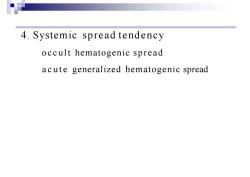
4.Systemic spread tendencyoccult hematogenic spreadacute generalized hematogenic spread
4. Systemic spread tendency o c c u l t hematogenic sp r ead a c u t e generalized hematogenic spread
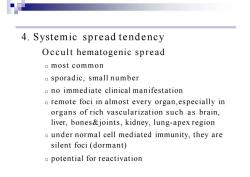
4. Systemic spread tendencyOccult hematogenic spread most common sporadic, small number no immediate clinical manifestation remote foci in almost every organ,especially inorgans of rich vascularization such as brain,liver, bones&joints, kidney, lung-apexregion under normal cell mediated immunity, they aresilent foci (dormant)- potential for reactivation
4. Systemic spread tendency O c cu l t hematogenic sp r ead □ most common □ sporadic, small n u mb er □ n o immediate clinical manifestation □ remote foci in almost every organ,especially in orga n s of rich vascularization su ch a s brain, liver, bones&joints, kidney, lung-apex region □ u n d er normal cell mediated immunity, they are silent foci (dormant) □ potential for reactivation
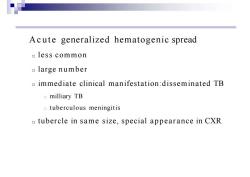
Acute generalized hematogenic spreadlesscommon large number immediate clinical manifestation:disseminated TBmilliary TBtuberculous meningitistubercle in same size, special appearanceinCXR
A c u t e generalized hematogenic spread □ less common □ large n u mb er □ immediate clinical manifestation:disseminated TB □ milliary TB □ tuberculous meningitis □ tubercle in s a me size, special a p p ea ra nce in CXR
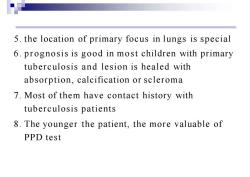
5.the location of primary focus in lungs is special6. prognosis is good in most children with primarytuberculosis and lesion is healed withabsorption, calcification or scleroma7. Most of them have contact history withtuberculosis patients8. The younger the patient, the more valuable ofPPD test
5. the location of primary focus in lungs is special 6. p r ognosis is good in most children with primary tuberculosis and lesion is healed with absorption, calcification or scleroma 7. Most of them have contact history with tuberculosis patients 8. The younger the patient, the more valuable of PPD test
按次数下载不扣除下载券;
注册用户24小时内重复下载只扣除一次;
顺序:VIP每日次数-->可用次数-->下载券;
- 《儿科学》课程教学课件(PPT讲稿)22 Infantale Diarrhea and Fluid Therapy.pptx
- 《儿科学》课程教学课件(PPT讲稿)23 Infantile Hepatitis Syndrome.pptx
- 《儿科学》课程教学课件(PPT讲稿)24 Mumps(Epidemic parotitis).pptx
- 《儿科学》课程教学课件(PPT讲稿)25 Scarlet Fever.pptx
- 《儿科学》课程教学课件(PPT讲稿)26 Rotavirus Infection in Children.pptx
- 《儿科学》课程教学课件(PPT讲稿)27 Inflammation Causes Cholesterol Redistribution by Diverting Cholesterol from Circulation to Tissue Tompartments.pptx
- 《儿科学》课程教学课件(PPT讲稿)20 Toxic Bacillary Dysentery.pptx
- 《儿科学》课程教学课件(PPT讲稿)21 Chronic Gastritis in Children.pptx
- 《儿科学》课程教学课件(PPT讲稿)06 新生儿败血症 Neonatal Septicemia.pptx
- 《儿科学》课程教学课件(PPT讲稿)07 新生儿缺氧缺血性脑病 Hypoxic-ischemic Encephalopathy(HIE).pptx
- 《儿科学》课程作业习题(试卷和答案)双语试卷A卷(答案).doc
- 《儿科学》课程作业习题(试卷和答案)双语试卷A卷(试题).doc
- 《儿科学》课程作业习题(试卷和答案)双语试卷C卷(答案).doc
- 《儿科学》课程作业习题(试卷和答案)双语试卷B卷(答案).doc
- 《儿科学》课程作业习题(试卷和答案)双语试卷B卷(试题).doc
- 《儿科学》课程作业习题(试卷和答案)双语试卷C卷(试题).doc
- 《儿科学》课程作业习题(典型病例)02 pneumonia.doc
- 《儿科学》课程作业习题(典型病例)01 ABO incompatibility of neonates.doc
- 《儿科学》课程作业习题(典型病例)03 congenital heart disease-TOF.doc
- 《儿科学》课程作业习题(典型病例)07 congenital hypothyroidism.doc
- 《儿科学》课程教学课件(PPT讲稿)18 Varicella.pptx
- 《儿科学》课程教学课件(PPT讲稿)17 Measles.pptx
- 《儿科学》课程教学课件(PPT讲稿)16 Growth Hormone Deficiency.pptx
- 《儿科学》课程教学课件(PPT讲稿)15 Congenital Hypothyroidism.pptx
- 《儿科学》课程教学课件(PPT讲稿)14 Immunodeficiency.pptx
- 《儿科学》课程教学课件(PPT讲稿)13 Acute Glomerulonephritis,Nephrotic Syndrome.pptx
- 《儿科学》课程教学课件(PPT讲稿)12 Acute Convulsion in Children.pptx
- 《儿科学》课程教学课件(PPT讲稿)11 Nutritional Iron Deficiency Anemia.pptx
- 《儿科学》课程教学课件(PPT讲稿)10 Haematopoiesis and Blood Cell Counts.pptx
- 《儿科学》课程教学课件(PPT讲稿)09 Congenital Heart Disease.pptx
- 《儿科学》课程教学课件(PPT讲稿)08 Respiratory Disorders.pptx
- 《儿科学》课程教学课件(PPT讲稿)05 Neonatal Jaundice,Hemolytic Disease of Newborn.pptx
- 《儿科学》课程教学课件(PPT讲稿)04 Nutrition During Childhood.pptx
- 《儿科学》课程教学课件(PPT讲稿)03 Development.pptx
- 《儿科学》课程教学课件(PPT讲稿)02 Growth.pptx
- 《儿科学》课程教学课件(PPT讲稿)01 Introduction of Pediatrics.pptx
- 重庆医科大学:《妇产科学》课程教学大纲 A Teaching Outline for Obstetrics and Gynecology Course(中英文双语).pdf
- 重庆医科大学:《妇产科学》课程授课教案(中文)06 妊娠期高血压疾病.doc
- 重庆医科大学:《妇产科学》课程授课教案(中文)04 异位妊娠.doc
- 重庆医科大学:《妇产科学》课程授课教案(中文)05 正常分娩.doc
